Top dressing of pears in spring and summer: how to fertilize for a high yield
You are probably looking for information on how to feed pears in the spring, in other words, you want to know what fertilizers are suitable for feeding the seed tree in spring.
Next, you will find out when, how and how to properly feed the pear in spring and summer, so that the tree blooms actively and bears fruit abundantly, and at the end pleases with a good harvest.
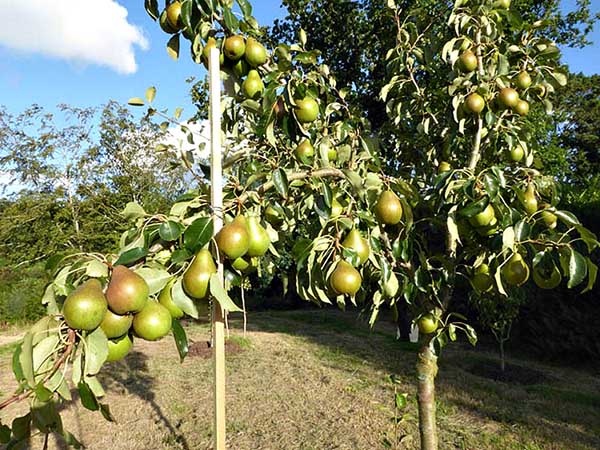
Content
Spring feeding of pears: goals and objectives
A pear, like any other fruit tree, needs a certain nutrition, namely a full complex of macro- (nitrogen, phosphorus and potassium = NPK) and microelements (the most important calcium, magnesium, boron, zinc, manganese, molybdenum, iron, copper other).
- Nitrogen - is required for the active growth of shoots and the development of the leaf apparatus (leaves), i.e. a set of vegetative (green) mass. This is especially true in the spring.
However! In no case do not overfeed your plants with nitrogen fertilizers, especially do not use them in the second half of the growing season (from July)!
- Phosphorus - is responsible for the development of the root system of the plant, as well as for the processes of formation of generative organs, flowering and fruit setting, in other words, it depends on it when the tree begins to bloom and set fruit.
- Potassium - improves carbohydrate metabolism, the processes of filling and ripening of fruits, and also accelerates the ripening of shoots, increases the immunity of the plant, its resistance to unfavorable growing conditions (drought and frost).
Phosphate and potash fertilizers (especially phosphorus), as a rule, are applied in a dry form already after fruiting (in autumn)so that they become available to plants next year. However, if you did not do this last fall, then you can feed it in the spring - before and after flowering, but by doing exactly liquid top dressing so that the plant receives nutrition immediately.
Naturally, main job perform macronutrients, directing metabolic processes towards protein (more nitrogen) or carbohydrate synthesis (more potassium). Micronutrients are designed to improve the absorption and functioning of macronutrients, thereby stimulating metabolism.
Since the pear is a seed crop (like the apple tree), it is particularly susceptible to deficiency calcium and magnesium, therefore, these microelements must be added in the form of dressings.
Thus, competent feeding of pears in the spring and summer period will have a positive effect on the green mass of the plant (the formation of annual growth and leaves), its fruiting - the quantity and quality (size, color, taste) of future berries, and will also have a beneficial effect on the immunity of the plant and its drought and frost resistance. And the tree will be able to lay fruit buds better (= new year's harvest).
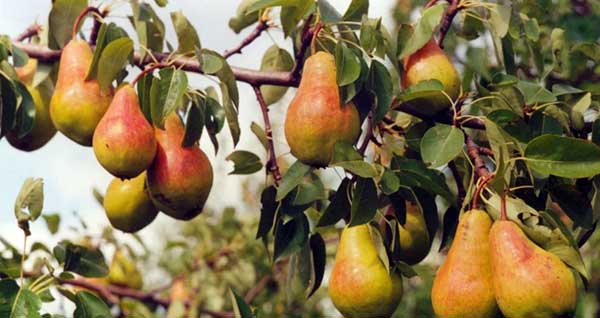
When and how to feed pears in spring and summer: timing and fertilization schedule
As a rule, all fruit trees (pome and stone fruit), including pears, are fed at least 3 times per season, focusing on the phases of plant development.
The scheme for feeding pears (seed crops) in spring and summer is as follows (the main dressings are highlighted in bold):
- in early spring (Can I have some more "in the snow ") - nitrogen-phosphorus-potassium root feeding is performed, i.e. complex (for example, use nitroammophoska) or purely nitrogen (ammonium nitrate);
- before flowering (after bud swelling);
- at the beginning of flowering (7-10 days before the blooming of flower buds, if the weather is unfavorable = cold);
- after flowering - nitrogen foliar feeding (urea);
- after the formation of ovaries;
- after fruiting (in autumn) - phosphorus-potassium root top dressing (superphosphate + potassium sulfate or potassium monophosphate).
By the way! The site already has an article about how and what to feed apple trees in autumn (for pears everything is the samesince both pome crops).
Next, let's talk about the nuances and the need for feeding at each of the stages of pear development.
Early spring (before bud break)
The first pear feeding is carried out in early springwhen a positive temperature is only established (snow is actively melting) and the tree begins to wake up (its buds are just swelling), that is, after you spend spring pruning pear.
Moreover, feeding can be done straight "in the snow", i.e. scatter granules over the tree trunk circle when there is still snow in it.
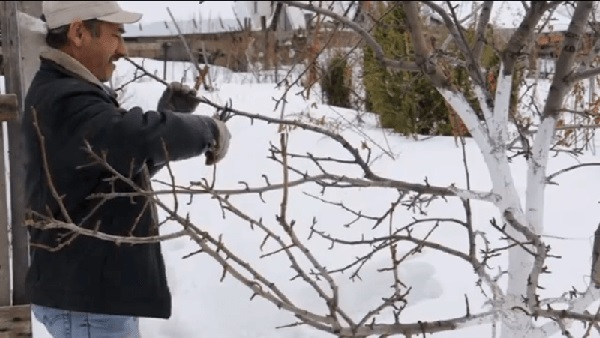
At this point, the plant needs a lot of nitrogen to build up green mass.
Accordingly, you can use mineral fertilizers: ammonium nitrate (you can even still in the snow) or urea (when the temperature is above +10).
Think! On the other hand, in order for potassium and phosphorus to dissolve and be "drawn in" by the plants, it is better to add them right now. Therefore, for this top dressing, it is convenient to use complex fertilizers, which contain all macronutrients, including nitrogen, for example, you can use a nitroammophos (all 16%).
During the same period, you can mulch the pear tree trunk circle with compost or humus (these are excellent organic nitrogen fertilizers of prolonged, i.e. long-acting).
Before flowering
For fruits to gain weight and sweetness, they need sufficient potassium and phosphorus nutrition (especially potash).
However, if you apply dry potassium-phosphorus fertilizers (potassium sulfate and superphosphate or the same nitroammofosk (or diammofosk), the pear will not immediately receive the required macronutrients.
By the way! That is why potash and phosphate fertilizers (special phosphoric) bring in from autumnso that they are available to plants next spring.
Therefore, if you didn't feed your trees with phosphate fertilizers last fall, then this must be done now, but already in liquid formby dissolving one or more fertilizers in water.
However! If you did potassium-phosphorus fertilizing in the fall, then in the spring it is no longer required, unless you can give a little potassium.
- Mineral potash fertilizers: potassium sulfate, potassium magnesium (+ magnesium), potassium nitrate (+ nitrogen).
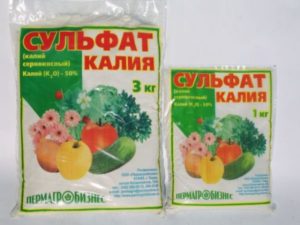
- Phosphate fertilizers — superphosphate, ammophos.
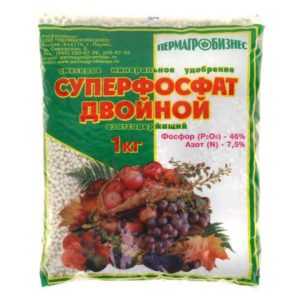
- Potassium-phosphorus - potassium monophosphate.
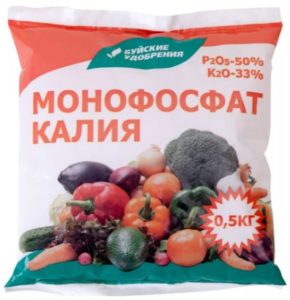
At this point, you can also use and organic fertilizers: the same infusion of chicken manure, mullein, which, in addition to nitrogen, also contains phosphorus, potassium and other trace elements.
Wood ash - another excellent potassium-phosphorus organic fertilizer, which contains many trace elements.
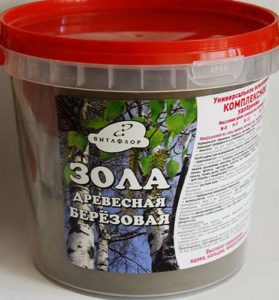
Also during this period you can give calcium and magnesium supplementation, of course, if necessary (you have acidic soil and there is a calcium deficiency or lack of magnesium).
- Calcium fertilizers - calcium nitrate (nitrogen + calcium).
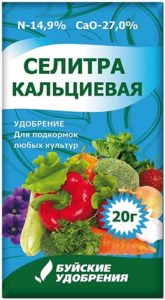
Or you can add one of the soil deoxidizers (if your soil is acidic): chalk, lime or dolomite flour... However, this is usually done in the fall.
- Magnesium fertilizer - magnesium sulfate.
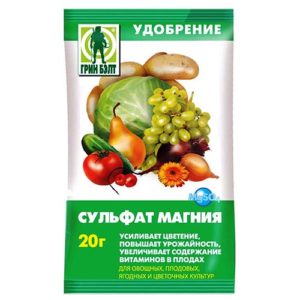
During flowering
If the weather is unfavorable (it is cool enough, so to speak, the weather is not flying for bees), then improve fruit setting, very good early flowering (even preferably more on a pink bud, i.e. 7-10 days before the blooming of flower buds) spend foliar feeding (per sheet) pears boron.
By the way! Boron also increases the sugar and vitamin C content of fruits.
After flowering and at the beginning of ovary formation
If you have not previously applied nitrogenthen now it's time to do it (5-7 days after flowering).
Moreover, you can conduct exactly foliar feeding - spraying pears with a solution urea, and repeat after 3-4 weeks.
Alternatively, you can spill the pear's trunk circle with a liquid solution. ammonium nitrate, infusion of chicken droppings or mullein.
Note! You should not do any more nitrogen fertilizing, nitrogen is introduced strictly until July (better even before the end of May or early June).
After the formation of ovaries
During this period, you can use complex potash-phosphorus fertilizers, as well as micronutrient fertilizers (with trace elements) in fast-digesting (chelated) form, again producing foliar feeding.
For example, for this, Potassium monophosphate, Plantafid and AgroMaster from the Russian company Agromaster, Aquarine from the Buisk chemical plant (potassium monophosphate is produced by the same plant), Potassium humate, Humate +7.
After harvest - autumn feeding
The purpose of the last (autumn) pear feeding is to make the tree strengthened its root systemso to speak increased winter hardiness (especially it concerns young pears, in this case, the trees will be able to more easily endure severe frosts and temperature drops), and also improved their immunity - resistance to various kinds of diseases.
And of course, so that an adult fruiting pear will lay flower buds = prepare for the next harvest.
Accordingly, a pear during this period requires a lot phosphorus and potassium. For example, you can give superphosphate and potassium sulfate or just potassium monophosphate. Of course, it is desirable to do this in liquid form (in the form of a solution), but it is also possible in dry form (so that food becomes available by the next season).
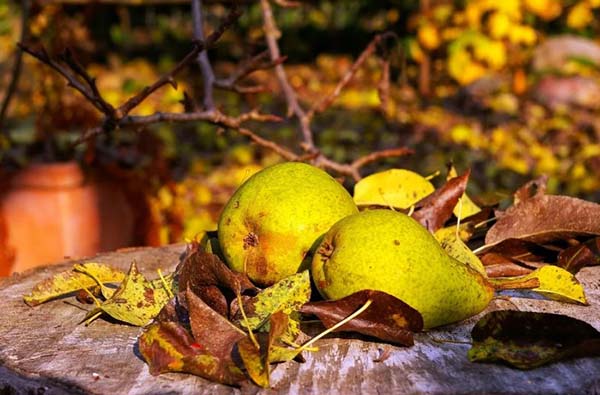
Fertilizers for pears (fruit trees and berry bushes)
If you do not want to bother (you are a "lazy" summer resident), you can buy one of the special complex fertilizers for pears (and fruit trees), which already contains all the macro- and microelements (all apply and dilute according to the instructions on the packages):
- Gumi-Omi "Fruit trees and shrubs".
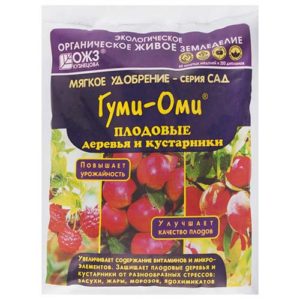
- Specialized fertilizers are especially popular prolonged action... For example, "Spring"From" Fusco ".
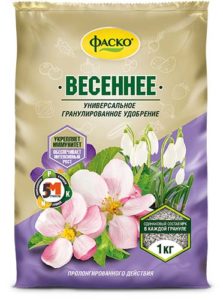
- Aquarine "Fruit and Berry" from "Buy Fertilizers".
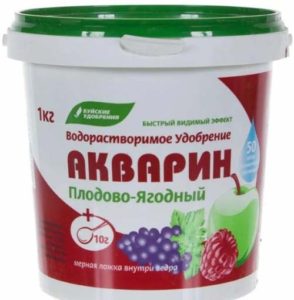
- Hera "Orchard" other.
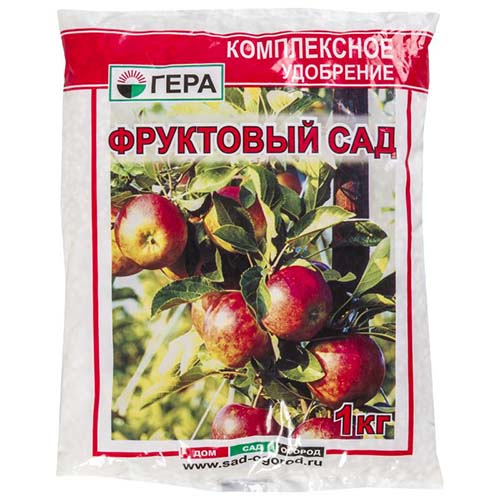
How to properly feed under a pear: types and methods of feeding
Fertilization rules
Recommendations for spring and summer feeding of pears:
- A 1-2 year old pear seedling, planted last year, does not need to be fed in the spring if sufficient nutrients = fertilizers were added to the soil during planting.
They begin to feed only after 2-3 years, since only by this time the plants will have pulled out of the soil all the nutrients introduced during their planting.
- Before liquid feeding it is recommended spill the tree with plain water firstsince it is always necessary to fertilize on wet soil, especially with mineral fertilizers.
By the way! You can water it a day or 1-2 hours before feeding.
- It is desirable to make top dressing in the morning or evening hoursbut not at noon when the sun is at its zenith. It's another matter if cloudy day - then it is possible in the afternoon.
- Any granular mineral fertilizer better pre-dissolve in a separate container in hot water (you can use boiling water), since granules, as a rule, dissolve in cold water rather poorly and slowly.
Methods or types of feeding
Exists 2 ways or type of feeding any plant (including pears):
- root (embedding or watering around the crown perimeter)
- foliar (by leaves).
Let's take a closer look at each of them.
As a rule, it is in the spring major root dressing... And now closer to summer or summer can be done and foliar feeding (by leaves).
Root dressing
Root feeding means applying fertilizer directly under the root of the plant, however, in this case (when feeding a tree) fertilizer needs to be applied not under the barrel, but in the near-barrel circle along the perimeter (projection) of the crown, i.e. stepping back from the trunk by at least 50-70 cm (usually 1-2 meters). The fact is that it is at this distance that the roots of the tree are located, which you want to provide with food (feed).
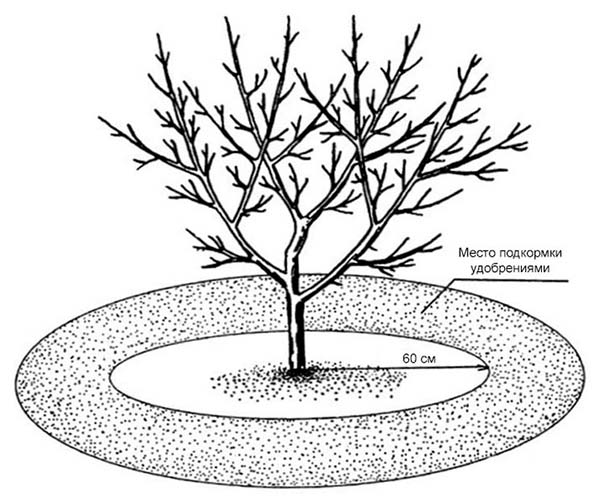
How to apply fertilizers correctly (do root dressing):
- Fertilizers must be applied along the perimeter (diameter) of the crown. In this case, you can first scatter the granules, and then embed them in the soil (with the help of a hoe, flat cutter), and introduce small doses into the recesses (pits). This method is also called "focal".
The essence of the focal feeding method: you need to make 10-12 holes 20-30 cm deep along the perimeter of the crown, in each of which add 100-200 grams of potassium sulfate (sulfate) and superphosphate, and then dig in. This fertilization is more than enough for the tree for many years.
The drawback of dry fertilization is that it will only gradually dissolve during watering or rains (i.e.this is a longer feeding, when the plant receives nutrition gradually).
By the way! At the same time, dry dressing is convenient to carry out during the rainy seasons, for example, in the same autumn or spring.
Naturally root dressing can also be done and in liquid form. In this case, the fertilizers must first be dissolved in water and again shed along the crown projection. So nutrition almost immediately reaches the roots of the plant.
For root dressing, as a rule, mineral fertilizers with macronutrients, and organic (including performing mulching).
Foliar dressing
In the case of foliar feeding of pears, fertilizers are applied through the aerial part of the tree, that is, through the surface of the leaves by spraying them.
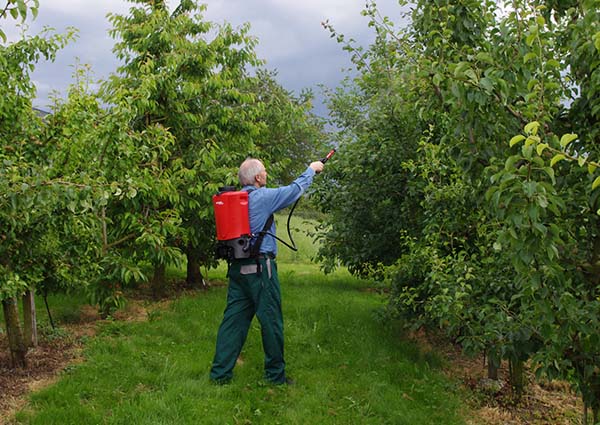
Note! It is believed that foliar feeding is most effective when the plant especially needs certain nutrients (which is manifested in its appearance), in other words, they are carried out as needed.
However, the effectiveness of such dressings still largely depends on weather conditions. Namely, it should be calm and cool. Therefore, as a rule, foliar feeding is performed early in the morning or in the evening.
During the day, foliar treatments, like any other spraying on the leaf, are extremely undesirable, except in cloudy weather and at temperatures no higher than +25 .. + 28 degrees.
- The most effective foliar dressing is spraying trees at the beginning of their flowering boron, (solution boric acid).
- The same urea (carbamide) it is better to use it after flowering as a foliar nitrogen dressing (20-30 grams per 10 liters of water).
- You can also use complex fertilizers with macro and microelements in a chelated (quickly assimilated by plants) form.
By the way! You can foliar pears together. with spring spraying of trees with pesticides against diseases and pests... As a rule, fertilizers can be added to solutions of fungicides and insecticides if there are no contraindications (for example, Bordeaux liquid better not to mix with anything).
Thus, foliar dressing, as a rule, is carried out with the help of fertilizers, which include trace elements, but fertilizers with basic macronutrients are often used (more often it is complex, in a rapidly digestible form).
It is worth understanding! Foliar dressing cannot completely replace root dressing. Therefore, the root is the main dressing, and the foliar is additional.
Features of feeding young and old pears: concentration and dose of fertilizers
Newly planted (= young) and already adults actively fruiting pears need different fertilizing from each other, more precisely in their various concentrations (the larger the tree, the more food it needs).
Clarification! Young - these are not yet fruit trees.
For example, for a small tree (up to 3 years old), 1-2 buckets of fertilizer solution are enough, for a 4-6-year-old tree - 2-3 buckets, for a tree up to 10 years old - 3-4 buckets, and for an older tree - 5 and more buckets.
Or here's another example: the recommended dose of potassium sulfate is 20-30 grams per 1 square meter of the trunk circle. Accordingly, on average, you will need to plant 60-180 grams of fertilizer per tree depending on its size and age (by 3-6 square meters).
Interesting! Many gardeners do not advise at all to feed any fruit trees until they begin to bear fruit, especially if you originally planted them in fertile soil (adding a supply of organic and mineral fertilizers to it).
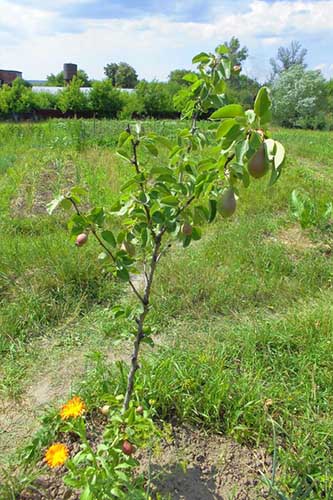
Well, now you know when and what you need to feed pears in spring and summer, so that they actively gain vegetative mass, bloom well, form many ovaries and, as a result, delight you with a large harvest of tasty and large pears. Fertilize wisely! Good luck!

